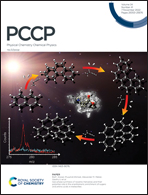A proof-of-concept study of the secondary structure of influenza A, B M2 and MERS- and SARS-CoV E transmembrane peptides using folding molecular dynamics simulations in a membrane mimetic solvent†
Abstract
Here, we have carried out a proof-of-concept molecular dynamics (MD) simulation with adaptive tempering in a membrane mimetic environment to study the folding of single-pass membrane peptides. We tested the influenza A M2 viroporin, influenza B M2 viroporin, and protein E from coronaviruses MERS-Cov-2 and SARS-CoV-2 peptides with known experimental secondary structures in membrane bilayers. The two influenza-derived peptides are significantly different in the peptide sequence and secondary structure and more polar than the two coronavirus-derived peptides. Through a total of more than 50 μs of simulation time that could be accomplished in trifluoroethanol (TFE), as a membrane model, we characterized comparatively the folding behavior, helical stability, and helical propensity of these transmembrane peptides that match perfectly their experimental secondary structures, and we identified common motifs that reflect their quaternary organization and known (or not) biochemical function. We showed that BM2 is organized into two structurally distinct parts: a significantly more stable N-terminal half, and a fast-converting C-terminal half that continuously folds and unfolds between α-helical structures and non-canonical structures, which are mostly turns. In AM2, both the N-terminal half and C-terminal half are very flexible. In contrast, the two coronavirus-derived transmembrane peptides are much more stable and fast helix-formers when compared with the influenza ones. In particular, the SARS-derived peptide E appears to be the fastest and most stable helix-former of all the four viral peptides studied, with a helical structure that persists almost without disruption for the whole of its 10 μs simulation. By comparing the results with experimental observations, we benchmarked TFE in studying the conformation of membrane and hydrophobic peptides. This work provided accurate results suggesting a methodology to run long MD simulations and predict structural properties of biologically important membrane peptides.



 Please wait while we load your content...
Please wait while we load your content...